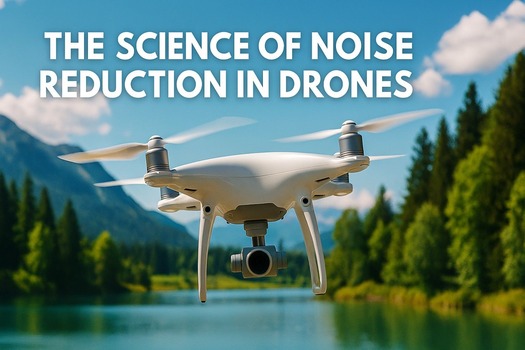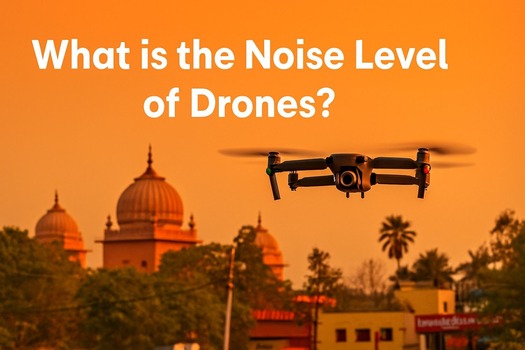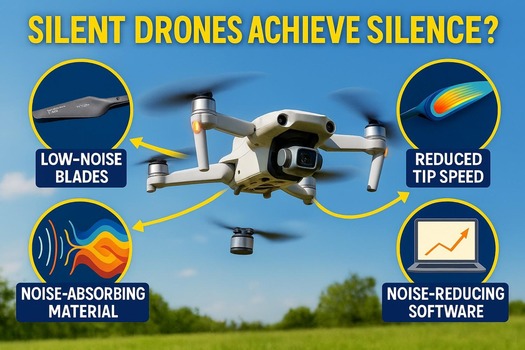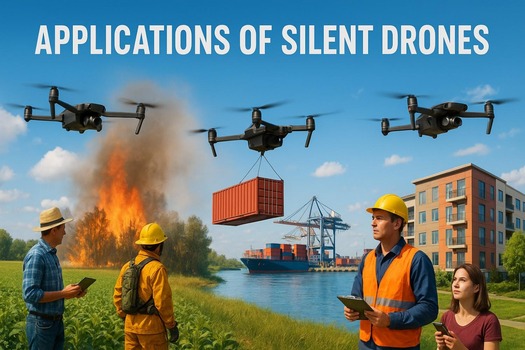How Drone Technology Is Helping in Smart City Development?
Smart cities promise an exciting future. The urban sprawls of tomorrow will feature a vast array of tech to make life easier, safer, and cleaner. The

Traditional drones buzz like insects, troubling peace and limiting their potential in sensitive environments. With technological advancements, silent drones have become extremely popular. This blog examines the noise issues affecting standard drones, the innovations behind quieter alternatives and the compelling reasons why they are needed.

The news about drones varies significantly depending on their size, propeller count, motor type and operational speed. Smaller drones produce noise about 70-80 decibels when hovering a few meters away. Larger drones can produce even higher noise, sometimes exceeding 90 dB.
This noise is most pronounced during takeoff and hovering, when the motors and propellers work at their most strenuous. Ambient suburban night noise ranges from 45 dB, so drones frequently exceed this background level, making them quite audible and disruptive.

The whine of a drone stems from its core mechanics. The primary reason for this is the propellers, which rotate at high speeds to produce lift and thrust. This fast spinning displaces air, creating turbulence and pressure waves that manifest as sound.
Key Contributors to the Drone Noise
●Aerodynamic Noise: The general movement of the blades through the air generates noise at higher speeds. This accounts for the majority of the sound.
●Blade Vortex Interaction: With the spinning of the propeller blade at high speeds, it chops through the air, making swirling vortices. When a following blade cooperates with the vortex shed by a preceding blade, it generates rapid pressure changes we observe as a loud, buzzing tone.
●Turbulence: Inadequacies in the blade design and the chaotic movement of air around the tips of the propellers create broad-spectrum, noisy turbulence.
●Motor Noise: While less dominant than propeller noise, the electric motors driving the propellers also contribute a humming sound.
●Structural Vibrations: The drone's frame can shudder in response to motor and propeller activity, further amplifying noise.

A silent drone is not a drone that produces absolutely no sound, but one that makes significantly lower noise. The purpose is to make the drone's presence unobtrusive, either by ear or through acoustic sensors, for precise applications.

These are not science fiction; they are the outcome of cutting-edge engineering and material science. Through enhanced propeller design, improved motor efficiency, and advanced frame damping, companies have developed quieter drones than their predecessors. For instance, some drones are up to 40% quieter than older drones.

Attaining a reduction in drone noise includes a multi-faceted approach, tackling several sound sources:
Propeller Optimization
●Advanced Aerodynamic Designs: Propellers are being designed with special shapes, extensive chords and optimized twist distributions to curtail blade-vortex interaction and decrease turbulence.
●Lower RPMs: Larger propellers can produce the same lift at lower rotational speeds, which inherently decreases noise.
●Multi-Bladed Propellers: While propellers with more blades can distribute the load and potentially decrease the noise produced by each individual blade.
●Serrated Edges and Biomimicry: Some designs include serrated or soft leading edges to disrupt vortices and reduce noise.
· Materials: Using lightweight, stiff and acoustically dampening materials for propellers can also play a role.
Motor and Drivetrain Innovations
●Encapsulation and Isolation: Motors can be surrounded in sound-dampening materials and isolated from the airframe to avert vibrations from propagating.
●Quieter Motors: Developing motors with tighter tolerances, enhanced bearing designs and cutting-edge control algorithms can minimize mechanical noise.
Airframe Design and Materials
●Aerodynamic Airframes: Streamlined drone bodies decrease air resistance and turbulence, contributing to overall quieter operation.
●Acoustic Metamaterials: These are engineered for absorbing, reflecting or redirecting sound waves, efficiently "hiding" the drone's acoustic signature.
●Vibration Damping: Incorporating vibration-absorbing materials and mounting systems within the drone's structure can decrease resonance and structural noise.
Novel Propulsion Systems
●Ducted Fans: Encasing propellers within a shroud can decrease tip vortices and redirect sound upwards, away from the ground.
●Electric Ducted Fans: These are promising for quieter operation, frequently found in jet-like drone designs.
●Hybrid and Alternative Propulsion: While exploring propulsion methods beyond traditional propellers could open new avenues for silent flight.

●Protect Privacy and Reduce Disturbance – In urban or residential areas, quieter drones come in handy for minimizing complaints and improving community acceptance.
●Allow Sensitive Operations – Search and rescue teams, wildlife researchers and journalists frequently need to fly without drawing attention from the general public.
●Improve Security Applications – Law enforcement and defence need drones that can function discreetly.
●Enhance user experience – Filmmakers, surveyors and commercial users benefit from drones that don’t interfere with audio recording or disrupt the environment.
Types of Specialized Silent Drones
Silent drones are of many different sizes. Common categories include:
●Silent Drone with Night Vision: They are an essential tool for security, law enforcement, and SAR. The combination of near-silent operation and thermal/infrared imaging allows for discreet surveillance and life-saving missions in darkness without detection.
●Silent Drone with Camera: The ability to capture intimate, undisturbed footage of wildlife or events without the noise allows a new level of storytelling.

●Aerial Photography and Videography: Silent drones help to provide a serene flight for capturing superior imagery without noise disruption.
●Surveillance and Security: These kinds of drones also help in conducting discreet monitoring of sensitive areas without alerting bystanders.
●Wildlife and Environmental Monitoring: These drones also prove their worth in observing animals without disturbing their natural behaviour.
●Search and Rescue Operations: Quiet drone operations allow for better coordination and communication in vital search and rescue missions.
●Urban Delivery and Infrastructure Inspection: Silent drones help to decrease noise-related complaints in inhabited areas, while they are used for last-mile delivery.

While drones are an essential technological upgrade, their noise is a barrier to extensive acceptance. Silent drones enable new applications where discretion, privacy, and safety matter most. Through continuous research, we can expect next-generation drones to fly farther, while also being much quieter. Unlock the full potential of your silent drones. If you want to buy a silent drone or want to learn drone piloting, you can contact Flapone Aviation.
Whether you're a beginner or looking to upskill, our training advisors can help you choose the right course.